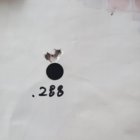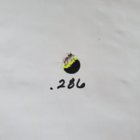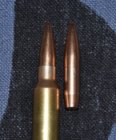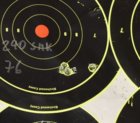You are using an out of date browser. It may not display this or other websites correctly.
You should upgrade or use an alternative browser.
You should upgrade or use an alternative browser.
Seating depth in case
- Thread starter LHH
- Start date
Fast14riot
Gold $$ Contributor
Seating depth is always measured by relationship to the lands. Only exception is magazine length, but you should still know its relationship to the lands.
Yes, it very much affects group size. Seating depth increments are typically .003".
Yes, it very much affects group size. Seating depth increments are typically .003".
Question on seating bullet deep or shallow in case?
Aside from pressure differences, does this have an effect on accuracy?
Not jumping bullets, seating into lands or neck tension, just the depth of the bullet in the case or neck.
Thanks
Like neck tension, there's a change in the resistance for the projectile to move due to an increase or decrease in the surface contact between the projectile and the neck. Does that have an effect on accuracy? Yes, but it's so small that it's probably not measurable on paper even at distance. Defiantly, it's not anywhere close to being a major factor in which it changes the interior volume, thereby significantly effecting pressure.
PS: Only other accuracy issue I can think of is having the projectile seated enough to maintain some concentricity . . . especially when feeding from a magazine. If concentricity is too far off, accuracy will suffer.
Last edited:
I understand what you're asking.
The truth is... It doesn't make a difference. The 30 Wolfpup cartridge is a blatant example.
I have some chambers with little freebore and some bullets have to be seated deep inside the case. Accuracy is great.
No different than the chambers I load for that have long freebore and the bullet's bearing surface/boat tail junction is well above the brass shoulder neck junction.
The truth is... It doesn't make a difference. The 30 Wolfpup cartridge is a blatant example.
I have some chambers with little freebore and some bullets have to be seated deep inside the case. Accuracy is great.
No different than the chambers I load for that have long freebore and the bullet's bearing surface/boat tail junction is well above the brass shoulder neck junction.
I've been playing with RL17 and 123 scenar's
After doing a seating depth test I wasn't happy with the load at distance even though it was shooting high .2's low .3's @ 100.
So I set up my next test to investigate neck tension with .286,.287,.288,.289 bushings.
I normally run a .288 bushing with really good results.
This measured .38" to my surprise this measured .23"
to my surprise this measured .23"  neck tension can really be an added benefit.
neck tension can really be an added benefit.
FWIW you can see the preasure ring of the scenar in the middle of the neck.
After doing a seating depth test I wasn't happy with the load at distance even though it was shooting high .2's low .3's @ 100.
So I set up my next test to investigate neck tension with .286,.287,.288,.289 bushings.
I normally run a .288 bushing with really good results.
This measured .38"
 to my surprise this measured .23"
to my surprise this measured .23"  neck tension can really be an added benefit.
neck tension can really be an added benefit. FWIW you can see the preasure ring of the scenar in the middle of the neck.
Yes it does make a difference , the only problem is that the difference is in the very things you don’t want to include . You can’t seat the bullet longer and it not get closer to the lands or deeper and it not effect start pressures or the jump . I’m not sure you can just say deeper or longer is better of how just that will effect accuracy because each of those cause other variables that will need to be calculated in .
I do think the generic answer would be no it doesn’t . The neck opens up releasing the bullet basically at the same time regardless as to how deep it’s seated . There again it still would depend on the leade of your chamber if longer or shorter really matters . In a Rem 700 , likely not much cus no matter your seating depth you are likely going to have a long jump , Savage not so much .
The only time I’ve cared about how deep my bullets are is when they might not be deep enough in the neck to hold the bullet it self during feeding .
I load 77gr smk to mag length for an AR . That means it’s seated really deep , to the point that all loads with that bullet and cartridge are compressed loads .
I do think the generic answer would be no it doesn’t . The neck opens up releasing the bullet basically at the same time regardless as to how deep it’s seated . There again it still would depend on the leade of your chamber if longer or shorter really matters . In a Rem 700 , likely not much cus no matter your seating depth you are likely going to have a long jump , Savage not so much .
The only time I’ve cared about how deep my bullets are is when they might not be deep enough in the neck to hold the bullet it self during feeding .
I load 77gr smk to mag length for an AR . That means it’s seated really deep , to the point that all loads with that bullet and cartridge are compressed loads .
Like neck tension, there's a change in the resistance for the projectile to move due to an increase or decrease in the surface contact between the projectile and the neck. Does that have an effect on accuracy? Yes, but it's so small that it's probably not measurable on paper even at distance. Defiantly, it's not anywhere close to being a major factor in which it changes the interior volume, thereby significantly effecting pressure.
PS: Only other accuracy issue I can think of is having the projectile seated enough to maintain some concentricity . . . especially when feeding from a magazine. If concentricity is too far off, accuracy will suffer.
The equation for static friction force contains no term related to surface area in sliding contact. If the normal force is the same and the friction coefficient the same, the grip is the same.
In cartridge terms, seating depth is not a factor in determining the force required to release a bullet.
I'm sure it does but I don't know what or how.
I do know that many models make simplifying assumptions that are just that simplifying. For instance the standard friction models are proven inadequate at every drag race. Seems that for a car to accelerate or brake at better than one G implies a cog railroad sort of tire friction contact patch. The standard brake shoe (now obsolete in a world of disc brakes) model for car brakes has no term for shoe width but shoe width does have some effect.
Similarly there was long held belief that seating depth should be at least one caliber in conflict with an opposite belief that a short neck as in the .300 Winchester Magnum as compared to the .300 H&H or .30-'06 contributed to improved accuracy - maybe related to a runout effect.
Some folks find that with long stored ammunition breaking the bullet loose by seating the bullet ever so slightly deeper improves performance. This says something about friction, possibly adhesive with sealants, which has to be related to contact patch.
I can only suggest to the OP that he buy a warehouse in Texas and conduct some experiments in short range bench rest. Maybe some thousand yard tests after that. I expect results to be lost in the noise and so inconclusive but I'm equally sure there will be some effect contributing to the noise.
I do know that many models make simplifying assumptions that are just that simplifying. For instance the standard friction models are proven inadequate at every drag race. Seems that for a car to accelerate or brake at better than one G implies a cog railroad sort of tire friction contact patch. The standard brake shoe (now obsolete in a world of disc brakes) model for car brakes has no term for shoe width but shoe width does have some effect.
Similarly there was long held belief that seating depth should be at least one caliber in conflict with an opposite belief that a short neck as in the .300 Winchester Magnum as compared to the .300 H&H or .30-'06 contributed to improved accuracy - maybe related to a runout effect.
Some folks find that with long stored ammunition breaking the bullet loose by seating the bullet ever so slightly deeper improves performance. This says something about friction, possibly adhesive with sealants, which has to be related to contact patch.
I can only suggest to the OP that he buy a warehouse in Texas and conduct some experiments in short range bench rest. Maybe some thousand yard tests after that. I expect results to be lost in the noise and so inconclusive but I'm equally sure there will be some effect contributing to the noise.
.I'm sure it does but I don't know what or how.
I do know that many models make simplifying assumptions that are just that simplifying. For instance the standard friction models are proven inadequate at every drag race. Seems that for a car to accelerate or brake at better than one G implies a cog railroad sort of tire friction contact patch.
Top fuel cars have massive wings that add several thousand pounds of downforce, which is why the cars accelerate faster after the 60ft lights than off the line. The faster they go, the more acceleration they have because of increased traction.
There’s also the weight transfer effect.
There is absolutely nothing occurring in drag racing that basic physics cannot fully explain.
Ummmm, top fuellers accelerate faster due to the tyres (ballooning is what it’s called) growing larger in circumference the faster they rotate.
Anyway, seating depth changes barrel harmonics and barrel time. This ‘tuning’ is what affects accuracy on an already accurate load.
Cheers.
Anyway, seating depth changes barrel harmonics and barrel time. This ‘tuning’ is what affects accuracy on an already accurate load.
Cheers.
This may provide more information than you wanted, but it answers your question.
http://www.the-long-family.com/OBT_paper.htm
If I understand correctly what Chris is writing, seating depth variations will change powder burn rate at the start of ignition through a variety of factors including bullet to barrel friction and therefore back pressure on the building pressure wave forming as the powder combusts. Since a modern powders burn rate is altered by pressure, or combustion within a confined space, the initial few inches of bullet travel can have a significant effect on the initial ignition of the charge and therefore how much and how fast pressure builds.
As you can imagine, one of the limiting factors to bullet movement is friction within the bore. But the bore size actually changes slightly, getting bigger and therefore reducing friction acting against bullet movement as the initial shock wave moves over the chamber end of the barrel. This happens while the bullet is making it's initial travel down the barrel. Moving the bullet fore or aft in the cartridge changes the bullet travel time with the goal being to not coincide with the arrival of the shock wave, and therefore helping the powder charge to ignite more thoroughly during initial bullet movement.
Hopefully this helps answer your question.
http://www.the-long-family.com/OBT_paper.htm
If I understand correctly what Chris is writing, seating depth variations will change powder burn rate at the start of ignition through a variety of factors including bullet to barrel friction and therefore back pressure on the building pressure wave forming as the powder combusts. Since a modern powders burn rate is altered by pressure, or combustion within a confined space, the initial few inches of bullet travel can have a significant effect on the initial ignition of the charge and therefore how much and how fast pressure builds.
As you can imagine, one of the limiting factors to bullet movement is friction within the bore. But the bore size actually changes slightly, getting bigger and therefore reducing friction acting against bullet movement as the initial shock wave moves over the chamber end of the barrel. This happens while the bullet is making it's initial travel down the barrel. Moving the bullet fore or aft in the cartridge changes the bullet travel time with the goal being to not coincide with the arrival of the shock wave, and therefore helping the powder charge to ignite more thoroughly during initial bullet movement.
Hopefully this helps answer your question.
As long as the load is developed in given seating condition, and that seated position had proven as best, good load density, and dismissing all else, I don't see how the condition itself would be a benefit or detriment.just the depth of the bullet in the case or neck.
I have not found it to be a consideration. Its the secondary effect on bullet jump that would pretty much negate the depth of seating causing a positive or negative resultQuestion on seating bullet deep or shallow in case?
Aside from pressure differences, does this have an effect on accuracy?
Not jumping bullets, seating into lands or neck tension, just the depth of the bullet in the case or neck.
Thanks
jackieschmidt
Gold $$ Contributor
In extreme accuracy shooting, such as Short Range Group and Score, seating depth is very important.
in a 30 BR, I would say it is second to powder charge in determining a competitive tune.
Through trial, and error, I have found that my 30BR likes a very specific seating depth, which is about .020 off the lands. I never change this.
The difference is a tune that will have a .300 agging capability, and one one that has a sub .200 agging capability. That’s the difference it consistently shooting 16/17 X’s, and shooting 20+ X’s on a consistent basis.
in a 30 BR, I would say it is second to powder charge in determining a competitive tune.
Through trial, and error, I have found that my 30BR likes a very specific seating depth, which is about .020 off the lands. I never change this.
The difference is a tune that will have a .300 agging capability, and one one that has a sub .200 agging capability. That’s the difference it consistently shooting 16/17 X’s, and shooting 20+ X’s on a consistent basis.
Similar threads
- Replies
- 0
- Views
- 1,068
- Replies
- 82
- Views
- 4,809
- Replies
- 29
- Views
- 16,488
Upgrades & Donations
This Forum's expenses are primarily paid by member contributions. You can upgrade your Forum membership in seconds. Gold and Silver members get unlimited FREE classifieds for one year. Gold members can upload custom avatars.

Click Upgrade Membership Button ABOVE to get Gold or Silver Status.
You can also donate any amount, large or small, with the button below. Include your Forum Name in the PayPal Notes field.
To DONATE by CHECK, or make a recurring donation, CLICK HERE to learn how.

Click Upgrade Membership Button ABOVE to get Gold or Silver Status.
You can also donate any amount, large or small, with the button below. Include your Forum Name in the PayPal Notes field.
To DONATE by CHECK, or make a recurring donation, CLICK HERE to learn how.











